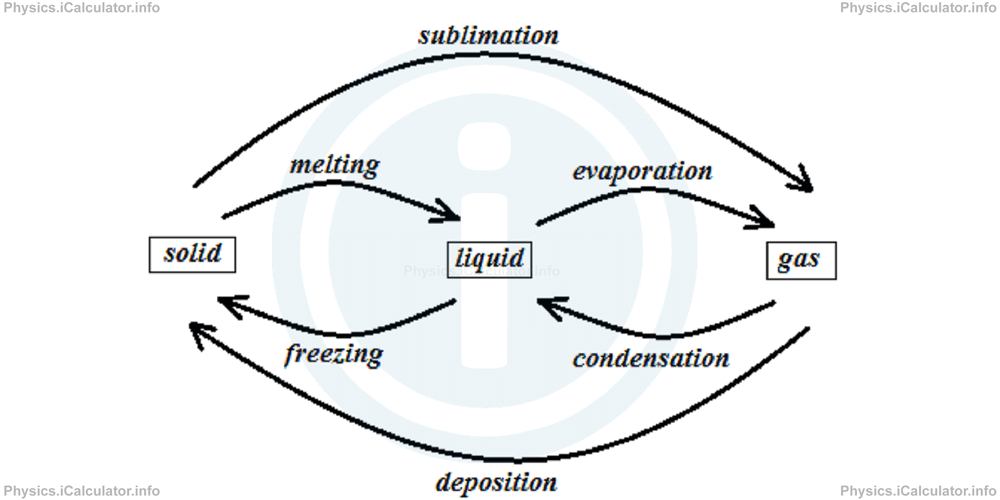Menu
Physics Lesson 13.3.4 - Change of State
Please provide a rating, it takes seconds and helps us to keep this resource free for all to use
Welcome to our Physics lesson on Change of State, this is the fourth lesson of our suite of physics lessons covering the topic of Absorption of Heat, you can find links to the other lessons within this tutorial and access additional physics learning resources below this lesson.
Change of State
When an object changes its phase, we say there is a change of state in it. There are six possible phase changes during a change in state.
- Melting. It occurs when a solid turns into liquid. During this process, temperature remains constant as the heat supplied to the object goes for breaking the strong molecular bonds, not for the increase in their kinetic energy.
- Freezing. It is the reverse process of melting that occurs when a liquid turns into solid. It occurs when the object gives off heat to the surroundings. After the termination of this process, atoms are more structured than before. Again, the freeing process occurs without any change in temperature.
- Evaporation. It occurs when a liquid turns into gas. Again, the heat supplied during evaporation does not contribute in the increase in temperature. It only allows atoms leave the liquid and move freely in space.
- Condensation. It is the reverse process of evaporation, i.e. it occurs when a gas turns into liquid giving off heat, without any change in temperature.
- Sublimation. Sometimes, a solid turns directly into gas due to the very large amount of heat it absorbs. During this process, the liquid phase is skipped.
- Deposition. It is the reverse process of sublimation, i.e. it occurs when a gas turns directly into solid without passing through the liquid state. This process occurs when the object gives off large amounts of heat at a very short time.
The following scheme gives a clearer idea about the relationship between various stages in states of matter during their phase change.

We use a special word to describe the process in which the evaporation takes place at the highest rate. It is known as "boiling". The boiling temperature is the highest temperature a liquid may have. For example, water boils at 100°C, which corresponds to the highest temperature of water in the liquid state.
You have reached the end of Physics lesson 13.3.4 Change of State. There are 5 lessons in this physics tutorial covering Absorption of Heat, you can access all the lessons from this tutorial below.
More Absorption of Heat Lessons and Learning Resources
Whats next?
Enjoy the "Change of State" physics lesson? People who liked the "Absorption of Heat lesson found the following resources useful:
- Change Feedback. Helps other - Leave a rating for this change (see below)
- Thermodynamics Physics tutorial: Absorption of Heat. Read the Absorption of Heat physics tutorial and build your physics knowledge of Thermodynamics
- Thermodynamics Revision Notes: Absorption of Heat. Print the notes so you can revise the key points covered in the physics tutorial for Absorption of Heat
- Thermodynamics Practice Questions: Absorption of Heat. Test and improve your knowledge of Absorption of Heat with example questins and answers
- Check your calculations for Thermodynamics questions with our excellent Thermodynamics calculators which contain full equations and calculations clearly displayed line by line. See the Thermodynamics Calculators by iCalculator™ below.
- Continuing learning thermodynamics - read our next physics tutorial: Calorimetry (Heat Transfer)
Help others Learning Physics just like you
Please provide a rating, it takes seconds and helps us to keep this resource free for all to use
We hope you found this Physics lesson "Absorption of Heat" useful. If you did it would be great if you could spare the time to rate this physics lesson (simply click on the number of stars that match your assessment of this physics learning aide) and/or share on social media, this helps us identify popular tutorials and calculators and expand our free learning resources to support our users around the world have free access to expand their knowledge of physics and other disciplines.
Thermodynamics Calculators by iCalculator™
- Carnot Engine Efficiency Calculator
- Entropy Calculator
- Gas Laws Calculator
- Molecular Mean Free Path Calculator
- Translational Kinetic Energy Of Gas Calculator
- Root Mean Square Speed Calculator
- Ideal Gas Law Calculator
- Change In The Gas Internal Energy Calculator
- Radiative Heat Transfer Calculator
- Evaporative Heat Transfer Calculator
- Convective Heat Transfer Calculator
- Conductive Heat Transfer Calculator
- Final Temperature Of Mixture Calculator
- Heat Absorbed Or Released Calculator
- Thermal Expansion Calculator
- Temperature Calculator